We’ve been very busy in our apiary the past week or so splitting our stronger wintered colonies. When conditions are right in the Spring, a healthy colony of bees will see its population expand very rapidly. Unless the beekeeper intervenes, the old queen will leave the hive with two thirds of the worker bee population, and find a place to set up shop elsewhere. You may have witnessed this process in action when you’ve seen a large ball of bees (e.g. a swarm) bivouacked on a tree or shrub in your yard. This is essentially bee reproduction at the macro level. If the process goes according to plan, the original colony resumes life as usual, only now it has a young vigorous queen, and a new daughter colony establishes its colony elsewhere with the original queen mother. We beekeepers, understandably, like to keep our bees hived in our own equipment, and not in the neighbor’s soffet. Splitting a healthy colony into two or more colonies is a good way to counter the bees natural instinct to swarm, and in these days of high priced package bees, it is also a great way to replenish your apiary’s winter loss. The key factor here is to time the split right. If you split before the colony is strong enough, the splits may not have enough bees establish themselves. You need a decent number of bees to keep the developing brood at 95 degrees – a tall task for a small number of bees on a chilly Spring night. If you wait to long, it will be too late, and your colonies will cast their swarms and some other lucky beekeeper will be hiving them. Or, more likely, they’ll end up in a nearby tree cavity or in somebody’s attic only to die when the cold weather sets in.
We’ve always split our colonies in the Spring and in more recent years we’ve also started raising our own queens from our survivor stock. We’re experimenting with a variety to non-graft approaches this year, and we’ll report later when the results are in. Perhaps the easiest way to raise a queen from a survivor colony is to simply let the bees do their thing. Instead of introducing a new purchased queen into the queenless portion of a split, we just make sure there is a frame of eggs or 1 day old larva in the split. Within the hours the bees realize their are queenless, and will start new queen cells. While this has always worked well for us in the past, the down side is that we can’t be as selective as we’d like to be. Instead of letting each split rear its own queen what we’d like to do is select the 1-2 colonies in our apiary that have the traits we want (e.g. have survived the Michigan winter, have the lowest mite counts, are gentle and easy to work with, good honey producers) and then raise daughter queens from only those colonies. This is what we’re trying to accomplish in the apiary at the moment. Eventually, we’d like to get to a point where we can minimize the need to purchase package bees, nucs, and caged queens from outside sources in the Spring and keep our equipment populated with bees we’ve selected and raised over the years ourselves.
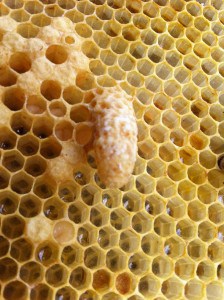
Close of up a queen cell - the peanut shaped protrusion from the comb. This developing queen is around 9 days old, and will hatch in around a week into a beautiful young queen bee.

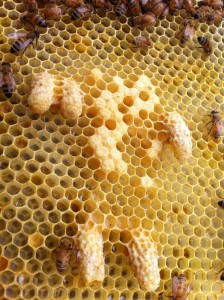
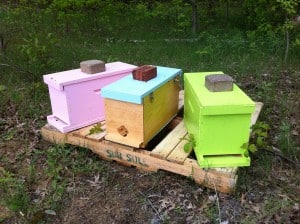
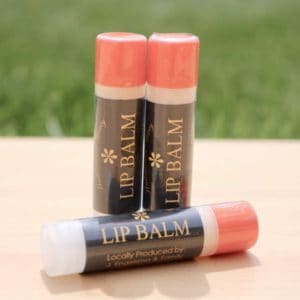
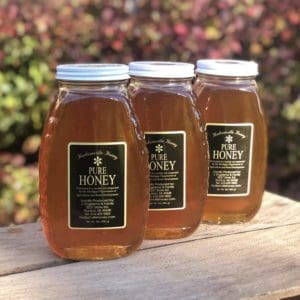
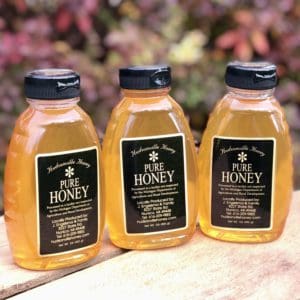
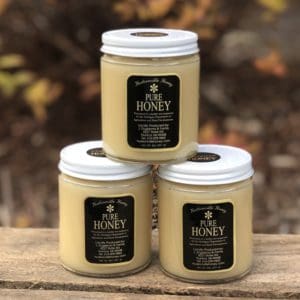
Thank you for this information. I am a novice bee-keeper and have had success with experimenting in the way which you have described.
I’m curious about your reference to a ‘double-screen’ split. What do you mean by a screen, and where does the double come in? This is terminology with which I am not familiar. Many thanks.
Hello Jim,
We basically separate the broodnest with a double screen, making sure there is eggs or one day old larva on the queen-less side. Once a new queen has developed and is laying, we separate them into two colonies. If they fail to raise a queen within 3-4 weeks we simply remove the screen and reunite the colony. Either way it tends to reduce the swarming tendency with a relatively risk-free attempt to split. The screen also allows the splits to share resource with regard to keeping the broodnest warm.
We make our own double screens, but here’s a link to the one offered by Walter T. Kelley. They also have a description of the process in their catalog entry, and you’ll find plenty of articles online if you Google.
http://kelleybees.com/CMS/CMSPage.aspx?OrganizationId=3&pageName=productDetail&productId=22061|Product
Thanks for stopping by, I hope this clarifies things a bit for you.
Jonathan
I was checking out your website and i am very interested in the idea of raising queen cells from splits,
I Kenya were i operate from raising queen cells is quite difficult because our African bees are too aggressive so i have been thinking that maybe the way to go is to do splits, 1 frame honey/pollen, two frames sealed brood and one frame open brood/day old larva, and let the nuc raise the queen cell.since i place 2 hives per hive stand i split one hive then place the nuc on the position of the brood box and move the split hive to another stand with the entrance facing the opposite side.
I would like to know you opinion on this
Regards
Hello Ernest,
I don’t have any experience with A. m. scutellata whatsoever, but what you describe sounds logical. I’m told your bees are very swarmy. Maybe move the brood box with old queen to an entirely different location would be something to think about.
Thanks for stopping by.
Jonathan
Good article.. Is there a follow up? I’m trying this next weekend with one of my survivor hives.. great bees, sweet natured and gentle.. The queen is excellent and is laying up a storm! How did your queens daughters do? [email protected] bruce smith